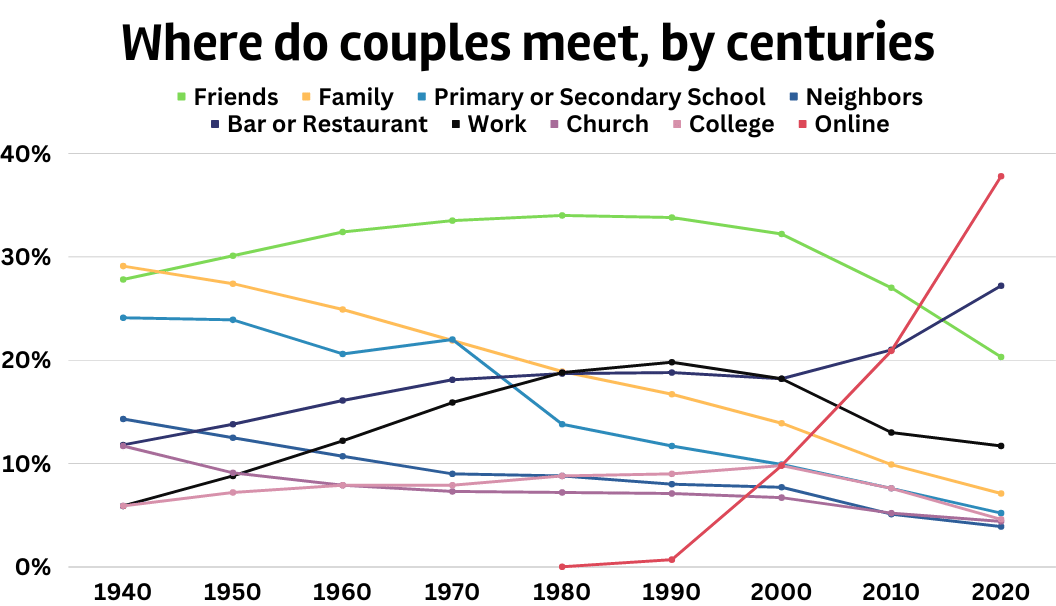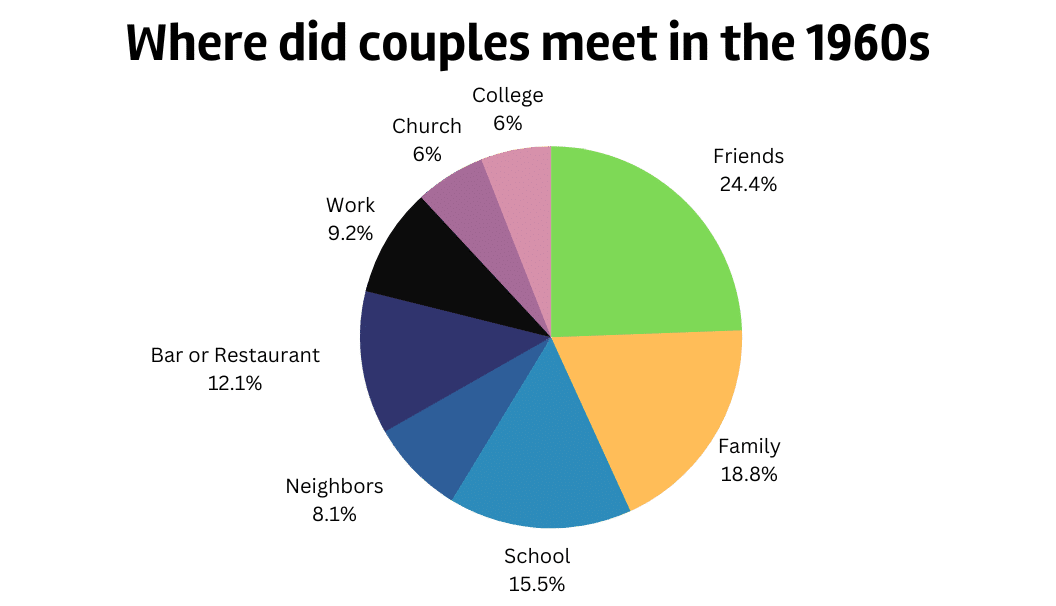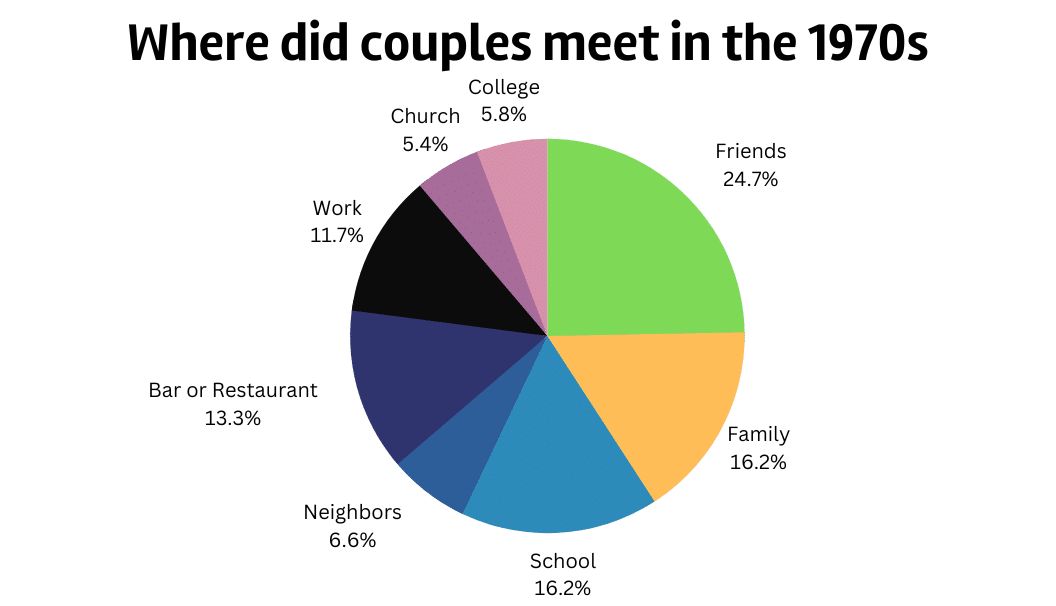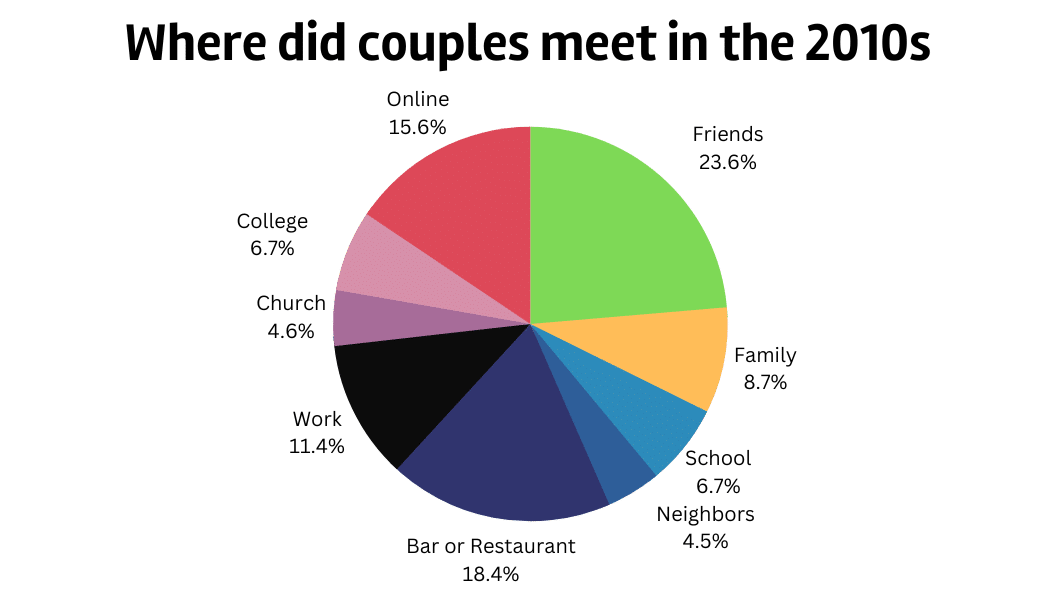![Where Do People Meet Their Spouses [Statistics]](https://wp.bedbible.com/wp-content/uploads/2024/05/Where-Do-People-Meet-Their-Spouses-Statistics.png)
In this report, we explore the evolving trends in how couples have met their spouses from 1940 to 2020.
By analyzing data spanning 80 years, we uncover the changing landscapes of romance, from traditional settings like family gatherings to modern platforms such as online dating.
This study provides a concise overview of the cultural and societal shifts that have influenced where people find love over the decades.
Here’s what we’ve covered:
- The Overview – trends in where couples meet
- In 1940s
- In 1950s
- In 1960s
- In 1970s
- In 1980s
- In 1990s
- In 2000s
- In 2010s
- In 2020s
Top Findings
- 38% meet their spouse through online dating, making it the place where most people meet their spouse today.
- The second most common place that people meet their spouse is in a bar or restaurant (27%)
- The third most common place that people meet their spouse today is through friends with 20% meeting their current partner that way.
- Almost 12% meet their spouse through or at work.
- Other places where people have met their partners are through family (7%), neighbors (4%), church (4%), and college (5%).
- Meeting through friends was the most common way from the 1950s up until 2010, with over 30% of couples meeting this way. In the 2020s, it was surpassed by online dating and meeting in bars and restaurants.
- In the 1940s, 29% of couples met their future spouse through family connections. The least frequent way couples meet today is through or with neighbors, dropping from nearly 15% to less than 4%.
- Couples meeting in primary or secondary school have declined from 24.1% in the 1940s to 5.2% in the 2020s.
- Meeting at bars or restaurants has increased over time, growing from 11.8% in the 1940s to 27.2% in the 2020s.
- Church as a place to meet a partner has seen a steady decline from 11.7% in the 1940s to 4.4% in the 2020s.
The Overview – trends in where couples meet
- 37.8% of couples who were together in 2020 and after have met through online dating (20.9% in the 2010s, and 9.8% in the 2000s).
- Meeting a future partner or spouse through friends has been the most common way to meet since the 1950s up until 2010, with more than 30% meeting this way. Only surpassed by online dating and meeting in bars and restaurants in the 2020s.
- In the 1940s meeting your future spouse was most likely to happen through family connections (29% of couples met this way).
- The least frequent way couples meet today is through or with neighbors. It used to be almost 15% of couples, and it is now less than 4% of couples.
- Meeting through friends remains a popular way to meet a partner, although it has decreased from 27.8% in the 1940s to 20.3% in the 2020s.
- There has been a decline in couples meeting in primary or secondary school from 24.1% in the 1940s to 5.2% in the 2020s.
- Meeting at bars or restaurants has increased over time, growing from 11.8% in the 1940s to 27.2% in the 2020s.
- Couples meeting at work have also increased, peaking at 19.8% in the 1990s, and slightly declining to 11.7% in the 2020s.
- Church as a place to meet a partner has seen a steady decline from 11.7% in the 1940s to 4.4% in the 2020s.
- Meeting at college has remained relatively stable, fluctuating between 5.9% and 9.8% over the decades.
- It can be speculated that Covid-19 and remote classes could be a significant driver of the -3% decline from 2010s (7.6%) to 2020s (4.6%).
- The overall trend shows a decrease in traditional meeting places (family, neighbors, school, and church) and an increase in more modern meeting places (bars, restaurants, work, and online platforms).
- These trends might also indicate a shift in societal norms, moving away from tightly-knit communities and towards more individualistic and diverse social networks.

| Year | Friends | Family | School | Neighbor | Bar | Work | Church | College | Online | SUM |
|---|---|---|---|---|---|---|---|---|---|---|
| 1940 | 27.8% | 29.1% | 24.1% | 14.3% | 11.8% | 5.9% | 11.7% | 5.9% | – | 130.6% |
| 1950 | 30.1% | 27.4% | 23.9% | 12.5% | 13.8% | 8.8% | 9.1% | 7.2% | – | 132.8% |
| 1960 | 32.4% | 24.9% | 20.6% | 10.7% | 16.1% | 12.2% | 7.9% | 7.9% | – | 132.7% |
| 1970 | 33.5% | 21.9% | 22.0% | 9.0% | 18.1% | 15.9% | 7.3% | 7.9% | – | 135.6% |
| 1980 | 34.0% | 18.9% | 13.8% | 8.8% | 18.7% | 18.8% | 7.2% | 8.8% | .01% | 129% |
| 1990 | 33.8% | 16.7% | 11.7% | 8.0% | 18.8% | 19.8% | 7.1% | 9.0% | 0.7% | 125.6% |
| 2000 | 32.2% | 13.9% | 9.9% | 7.7% | 18.2% | 18.2% | 6.7% | 9.8% | 9.8% | 126.4% |
| 2010 | 27.0% | 9.9% | 7.6% | 5.1% | 21.0% | 13.0% | 5.2% | 7.6% | 20.9% | 117.3% |
| 2020 | 20.3% | 7.1% | 5.2% | 3.9% | 27.2% | 11.7% | 4.4% | 4.6% | 37.8% | 122.2% |
As multiple answers were allowed for respondents we also took the liberty to create a relative index, as it provides better historical comparison across centuries and places couples met.
Relative index
| Year | Friends | Family | School | Neighbor | Bar | Work | Church | College | Online | SUM |
|---|---|---|---|---|---|---|---|---|---|---|
| 1940 | 21.3% | 22.3% | 18.5% | 10.9% | 9.0% | 4.5% | 9.0% | 4.5% | – | 100% |
| 1950 | 22.7% | 20.6% | 18.0% | 9.4% | 10.4% | 6.6% | 6.9% | 5.4% | – | 100% |
| 1960 | 24.4% | 18.8% | 15.5% | 8.1% | 12.1% | 9.2% | 6.0% | 6.0% | – | 100% |
| 1970 | 24.7% | 16.2% | 16.2% | 6.6% | 13.3% | 11.7% | 5.4% | 5.8% | – | 100% |
| 1980 | 26.4% | 14.7% | 10.7% | 6.8% | 14.5% | 14.6% | 5.6% | 6.8% | .01% | 100% |
| 1990 | 26.9% | 13.3% | 9.3% | 6.4% | 15.0% | 15.8% | 5.7% | 7.2% | 0.6% | 100% |
| 2000 | 25.5% | 11.0% | 7.8% | 6.1% | 14.4% | 14.4% | 5.3% | 7.8% | 7.8% | 100% |
| 2010 | 23.0% | 8.4% | 6.5% | 4.3% | 17.9% | 11.1% | 4.4% | 6.5% | 17.8% | 100% |
| 2020 | 16.6% | 5.8% | 4.3% | 3.2% | 22.3% | 9.6% | 3.6% | 3.8% | 30.9% | 100% |
Where did couples meet in the 1940s
- 27.8 percent of couples who got together in the 1940s met each other through friends.
- 29.1 percent of couples who got together in the 1940s met each other through family.
- 24.1 percent of couples who got together in the 1940s met each other in Primary or Secondary School
- 14.3 percent of couples who got together in the 1940s met each other through neighbors.
- 11.7 percent of couples who got together in the 1940s met each other in church.
- 11.8 percent of couples who got together in the 1940s met each other in a bar or restaurant.
- 5.9 percent of couples who got together in the 1940s met each other through work or with a coworker.
- 5.9 percent of couples who got together in the 1940s met each other in college.

Where did couples meet in the 1950s
These are the top 8 places that couples formed in the 1950s report to have met.
- 30.1 percent of couples who got together in the 1950s met each other through friends.
- 27.4 percent of couples who got together in the 1950s met each other through family.
- 23.9 percent of couples who got together in the 1950s met each other in Primary or Secondary School.
- 13.8 percent of couples who got together in the 1950s met each other in a bar or restaurant.
- 12.5 percent of couples who got together in the 1950s met each other through neighbors.
- 9.1 percent of couples who got together in the 1950s met each other in church.
- 8.8 percent of couples who got together in the 1950s met each other through work or with a coworker.
- 7.2 percent of couples who got together in the 1950s met each other in college.

Where did couples meet in the 1960s
These are the top 8 places that couples formed in the 1960s report to have met.
- 32.4 percent of couples who got together in the 1960s met each other through friends.
- 24.9 percent of couples who got together in the 1960s met each other through family.
- 20.6 percent of couples who got together in the 1960s met each other in Primary or Secondary School
- 16.1 percent of couples who got together in the 1960s met each other in a bar or restaurant.
- 12.2 percent of couples who got together in the 1960s met each other through work or with a coworker.
- 10.7 percent of couples who got together in the 1960s met each other through neighbors.
- 7.9 percent of couples who got together in the 1960s met each other in church.
- 7.9 percent of couples who got together in the 1960s met each other in college.

Where did couples meet in the 1970s
These are the top 8 places that couples formed in the 1970s report to have met.
- 33.5 percent of couples who got together in the 1970s met each other through friends.
- 22 percent of couples who got together in the 1970s met each other in Primary or Secondary School.
- 21.9 percent of couples who got together in the 1970s met each other through family.
- 18.1 percent of couples who got together in the 1970s met each other in a bar or restaurant.
- 15.9 percent of couples who got together in the 1970s met each other through work or with a coworker.
- 9 percent of couples who got together in the 1970s met each other through neighbors.
- 7.9 percent of couples who got together in the 1970s met each other in college.
- 7.3 percent of couples who got together in the 1970s met each other in church.

Where did couples meet in the 1980s
These are the top 8 places that couples formed in the 1980s report to have met.
- 34 percent of couples who got together in the 1980s met each other through friends.
- 18.9 percent of couples who got together in the 1980s met each other through family.
- 18.8 percent of couples who got together in the 1980s met each other through work or with a coworker.
- 18.7 percent of couples who got together in the 1980s met each other in a bar or restaurant.
- 13.8 percent of couples who got together in the 1980s met each other in Primary or Secondary School
- 8.8 percent of couples who got together in the 1980s met each other through neighbors.
- 8.8 percent of couples who got together in the 1980s met each other in college.
- 7.2 percent of couples who got together in the 1980s met each other in church.

Where did couples meet in the 1990s
These are the top 9 places that couples formed in the 1990s report to have met.
- 33.8 percent of couples who got together in the 1990s met each other through friends.
- 19.8 percent of couples who got together in the 1990s met each other through work or with a coworker.
- 18.8 percent of couples who got together in the 1990s met each other in a bar or restaurant.
- 16.7 percent of couples who got together in the 1990s met each other through family.
- 11.7 percent of couples who got together in the 1990s met each other in Primary or Secondary School
- 9 percent of couples who got together in the 1990s met each other in college.
- 8 percent of couples who got together in the 1990s met each other through neighbors.
- 7.1 percent of couples who got together in the 1990s met each other in church.
- 0.7 percent of couples who got together in the 1990s met each other online (often through online dating services).

Where did couples meet in the 2000s
These are the top 9 places that couples formed in the 2000s report to have met.
- 32.2 percent of couples who got together in the 2000s met each other through friends.
- 18.2 percent of couples who got together in the 2000s met each other in a bar or restaurant.
- 18.2 percent of couples who got together in the 2000s met each other through work or with a coworker.
- 13.9 percent of couples who got together in the 2000s met each other through family.
- 9.9 percent of couples who got together in the 2000s met each other in Primary or Secondary School.
- 9.8 percent of couples who got together in the 2000s met each other in college.
- 7.8 percent of couples who got together in the 2000s met each other online (often through online dating services).
- 7.7 percent of couples who got together in the 2000s met each other through neighbors.
- 6.7 percent of couples who got together in the 2000s met each other in church.

Where did couples meet in the 2010s
These are the top 9 places that couples formed in the 2010s report to have met.
- 27 percent of couples who got together in the 2010s met each other through friends.
- 21 percent of couples who got together in the 2010s met each other in a bar or restaurant.
- 17.8 percent of couples who got together in the 2010s met each other online (often through online dating services).
- 13 percent of couples who got together in the 2010s met each other through work or with a coworker.
- 9.9 percent of couples who got together in the 2010s met each other through family.
- 7.6 percent of couples who got together in the 2010s met each other in Primary or Secondary School.
- 7.6 percent of couples who got together in the 2010s met each other in college.
- 5.1 percent of couples who got together in the 2010s met each other through neighbors.
- 5.2 percent of couples who got together in the 2010s met each other in church.

Where did couples who formed in 2020 and forth
These are the top 9 places that couples formed in the 2020s report to have met.
- 30.9 percent of couples who got together in the 2020s met each other online (often through online dating services).
- 27.2 percent of couples who got together in the 2020s met each other in a bar or restaurant.
- 20.3 percent of couples who got together in the 2020s met each other through friends.
- 11.7 percent of couples who got together in the 2020s met each other through work or with a coworker.
- 7.1 percent of couples who got together in the 2020s met each other through family.
- 5.2 percent of couples who got together in the 2020s met each other in Primary or Secondary School.
- 4.6 percent of couples who got together in the 2020s met each other in college.
- 4.4 percent of couples who got together in the 2020s met each other in church.
- 3.9 percent of couples who got together in the 2020s met each other through neighbors.

About the data
This analysis utilizes 2 different datasets in combination: the Stanford dataset; 3,510 respondents from the HCMST_2017 sample; and 51,020 respondents from the GSS (General Social Surveys) dataset.
